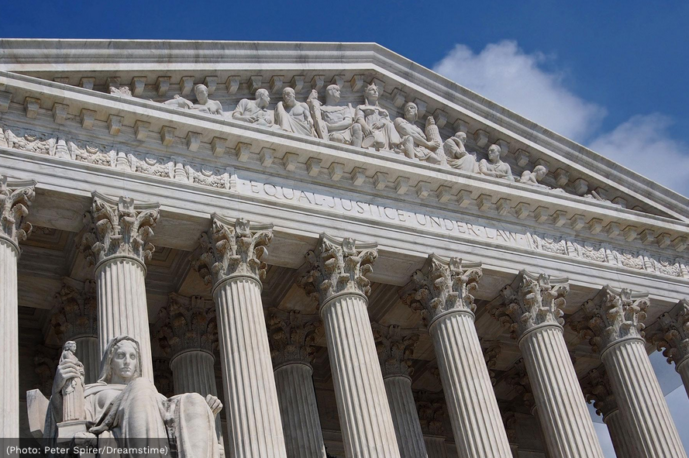While there are many threats to religious liberty, few are more consequential over the long term than the state’s ever-expanding role in private life. If the government is able to vacuum up tax dollars, create programs large and small for public benefit, and then exclude religious individuals or institutions from those programs, it has functionally created two tiers of citizenship. Secular individuals and institutions enjoy full access to the government they fund, while religious individuals and institutions find themselves funding a government that overtly discriminates against them.
That’s the issue the Supreme Court addressed today in Trinity Lutheran Church v. Comer. By a 7–2 margin, the Court held that when a state creates a neutral program for public benefit — in this case, a program that uses scrap tires to provide rubberized safety flooring for playgrounds — it can’t exclude a church from that program, even if that means state benefits flow directly to a house of worship. Justice Roberts, writing for the majority, was emphatic:
The Missouri Department of Natural Resources has not subjected anyone to chains or torture on account of religion. And the result of the State’s policy is nothing so dramatic as the denial of political office. The consequence is, in all likelihood, a few extra scraped knees. But the exclusion of Trinity Lutheran from a public benefit for which it is otherwise qualified, solely because it is a church, is odious to our Constitution all the same, and cannot stand.
The Court’s holding, secured by my friends and former colleagues at the Alliance Defending Freedom, is significant for two reasons. First, it places another brick in a wall of precedent that stands for the proposition that once the state creates a neutral program — one designed neither to advance nor to inhibit religious practice — it can’t exclude citizens or institutions from that program merely because they’re religious. Under these precedents, churches are able to worship in government buildings, religious student groups may access student activity fees to fund their campus outreach, parents may send their children to religious schools with publicly funded vouchers, and hosts of religious organizations may participate in public–private partnerships to serve our nation’s poorest and most vulnerable citizens. So entrenched is this precedent that it would have been a legal earthquake had the Court ruled against the church.
Second, seven of the nine justices concurred in the result of the case. This means that the principle of religious nondiscrimination in public programs has broad judicial support. Indeed, in recent years the Court has decided a number of significant religious-freedom cases unanimously or with overwhelming majorities. Yes, the Hobby Lobby case was a classically contentious 5–4 ruling, but other significant cases (such as Hosanna-Tabor v. EEOC, which kept the government out of significant church-hiring decisions, and Little Sisters of the Poor) achieved consensus.
Constitutional doctrine is usually created not by a judicial grand slam but rather through a long series of singles, stolen bases, and walks. Even the biggest cases rarely come out of nowhere but are rather forecast through other, smaller decisions. This case represents judicial progress — a sharp single into center field — and is well worth celebrating.
There are, however, storm clouds on the horizon. Justice Sotomayor wrote a sharply worded dissent (Ruth Bader Ginsburg joined) claiming that the Court’s decision “profoundly changes” the relationship between church and state “by holding, for the first time, that the Constitution requires the government to provide public funds directly to a church.” But this is overwrought. Again, given existing precedent, the “profound change” would have been a ruling against the church. The Court would have sanctioned outright anti-religious discrimination in areas as benign as tire recycling and playground resurfacing. That would have pushed Establishment Clause jurisprudence back from its trending neutrality to the outright anti-religious hostility of the most far-left judicial activists.
This case represents judicial progress and is well worth celebrating.
Moreover, the case created consensus in part because it didn’t touch on the hot-button cultural conflict between religious freedom and the sexual revolution. Just before the Supreme Court announced its ruling in Trinity Lutheran, it also announced that it would hear a Christian baker’s appeal in Masterpiece Cakeshop v. Colorado Civil Rights Commission, a case that could determine whether the state can compel citizens to lend their artistic talents to celebrate events they consider to be immoral. In this case, the question is whether a Christian baker can be required to help celebrate a gay wedding. It would be surprising indeed to see anything other than a 5–4 decision in that case, with Justice Kennedy likely providing the swing vote.
But that’s tomorrow’s concern. Today was a good day for religious liberty. Seven of nine justices took a hard look at a government program that explicitly discriminated on the basis of religion and rejected it out of hand. Today’s message was clear. People of faith aren’t second-class citizens, and their churches are entitled to equal treatment under the law.
Source: David French, nationalreview.com
 Listen Online
Listen Online Watch Online
Watch Online Find a Station in Your Area
Find a Station in Your Area









 Listen Now
Listen Now Watch Online
Watch Online
